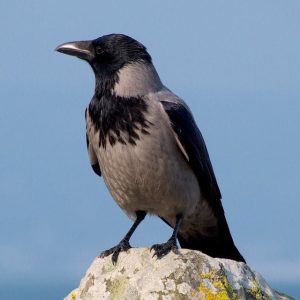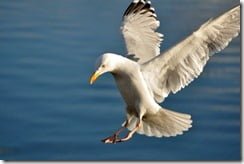 The hooded crow, grey crow or “hoodie” as it’s sometimes called, is almost identical to the closely related carrion crow (Corvus corone) except for its distinctive grey and black plumage. The two birds are so similar in fact that until recently they were considered to be different races of the same species, but now hooded crows have been formally acknowledged as a species in their own right. In a narrow strip where their ranges overlap the two species can and do interbreed, leading to fertile hybrid birds that exhibit a varying amount of grey plumage.
The hooded crow, grey crow or “hoodie” as it’s sometimes called, is almost identical to the closely related carrion crow (Corvus corone) except for its distinctive grey and black plumage. The two birds are so similar in fact that until recently they were considered to be different races of the same species, but now hooded crows have been formally acknowledged as a species in their own right. In a narrow strip where their ranges overlap the two species can and do interbreed, leading to fertile hybrid birds that exhibit a varying amount of grey plumage.
In Europe the dividing line between the two species extends roughly from Denmark to northern Italy. West of this line the carrion crow dominates, east and south of it the hooded crow takes over. The exception to the rule is the British Isles, with the carrion crow occurring almost exclusively in England, Wales and most of Scotland, replaced by the hooded crow in Ireland, the Isle of Man and Scotland’s north west.
Hooded crows are fairly large birds, with an overall length of between 44-51 cm (c. 17-20 inches) long, a wingspan of 84-100 cm (c. 33-39 inches) and weigh in at between 370-650 g (13-23 oz). In Ireland they are common in a wide variety of habitats, including open country with scattered trees and rocky crags, moorland, inland and coastal cliffs, open woodlands, forest margins and mountains areas. They’re also commonly seen in parks and large gardens in our towns and cities. Their harsh and croaky voice is a familiar sound, with a range of typically crow-like calls that includes a ‘kra-kra-kra‘ that some people believe to have given rise to the imitative name ‘crow’.
Hooded crows are omnivores and will eat practically anything. Their diet includes typically includes insects, molluscs and other invertebrates; other birds’ eggs; berries and fruit; fish and carrion. They are intelligent birds, and often come up with ingenious ways of reaching a potential meal. In Finland, for example, hooded crows have been observed “reeling in” fishing lines that people have left in ice-holes to get the fish before the fisherman returns.
Closer to home I’ve often seen them collecting mussels and other shell-fish near the shore, then carrying them to exactly the right height above the rocks before dropping them to crack the shells and expose the tasty flesh. It’s a delicate operation: too low and the shell won’t crack, too high and it will be smashed to smithereens, making the food difficult to retrieve. Experienced adult birds have honed the technique to a fine art.
Sexes are similar in appearance, but young birds have more mottled grey areas of plumage than adults. In spring the hooded crow builds a large nest of twigs in a tree or on a cliff-ledge, typically lined with wool or animal hair. In built up areas the birds may use buildings as surrogate cliff-faces if natural nesting sites are scarce.
Four to six greenish blue eggs with brown speckles are laid in the nest from March to May, and are incubated for 18-20 days. Once hatched the young birds stay in the nest for 4-5 weeks before they fledge. Hooded crows rear a single brood of young each year.
Hooded crows are common and widespread throughout Ireland, but like other crows they have endured centuries of human persecution. This is largely due to the belief that they kill young game birds and harm livestock – especially lambs. While they are undoubtedly capable of doing some damage in these areas, human perception, as is often the case, tends to be far worse than reality.
Image Credit: Hooded Crow, Helen’s Bay (Rossographer) / CC BY-SA 2.0










13 comments
Maxine
Place a picture of a face in the window or a child’s toy with large eyes. They are attacking their own reflections and the face puts them off.
Michelle
Two large hooded crows are attacking our sliding glass doors. They attack with such vehemence that they leave dirty marks and bloodstains all over them.. What can we do to stop them. Thanks.
Alfie deehan
We have a bird coming into our garden this last few days, looks like a Crow but is coffee coloured, The Crows don’t seem to like him and he seems to be a loner. I’ve tried giving him food but he hasn’t accepted any so far.
Would love to know what kind of bird he is and are there many in Ireland.
I live in Athenry.
My email address is [email protected]
Many thanks,
Alfie Deehan
Susanna Murphy
I got ‘attacked’ by a grey crow this morning on the pier in Dun Laoghaire while running with my son in his buggy. It seriously freaked me out. I felt a claw feeling on the crown of my head and when I looked up I saw this huge crow. I panicked and picked up my pace. A few onlookers uttered something. 30 seconds later he came down again and clawed in the same way. I yelped so much that I pushed the buggy ahead of me. I ran a little further and he seemed to stop following. On the way back, he swooped in on me twice more but onlookers shooed him away. I was wearing black running gear (as were a few others walking/running the pier). My hair was tied back and I had nothing necessarily shiny on (maybe my watch, my rings?!) It was overcast also. Please ease my concern with this. I’d love to go back to the pier tomorrow…. My skin was crawling all day and I’m not easily phased. I’ve run my whole life and never heard or or encountered this. What did I do to this crow in my former life?!
Kathy Scannell
Any solution Emer?? I’m having the same problem!
Emer
I have a large male attacking his reflection in our windows from 4:15am to 9:45 pm. Any ideas?
Margaret McGrath
Two large hooded crows are attacking our front porch and all the windows in the house. They attack with such vehemence that they leave dirty marks and bloodstains all over them.. What can we do to stop them. Thanks.
Maxine
Place a picture of a face in the window or a child’s toy with large eyes. They are attacking their own reflections and the face puts them off.
Owen
There is a pair of enormous hooded crows in my garden in co Louth they live in the highest tree easily 6/7 stories high and you can see them watching over about 3 separates yards waiting for something to catch once they appear on the ground all other birds disappear there clearly the king and queen of the garden an a big garden too.
John Skally
Hi Calvin, as I write I’m looking at a pair of hooded crows refurbishing the nest they built last year. As it is still only early November ,is this normal for hoodies? Regards John Skally.
Joanne O Donovan
The gray crow is just out side my door
Being chased by aload of black crows making some strange noises never seen so many birds were talking about over 20 birds chasing after it
Greg Coyle
Hi Calvin, I’m in East Point Business Park, Clontarf, on the 3rd floor looking out at a pair of Hooded Crows who just this week have began building a nest in a tree about 30 yds away for me. Greg Coyle
greg
Hi Calvin, am here in Bandon and have been befriended by what first appeared to be a young crow, but now appears to be a hooded crow. Have noticed that the more she befriends me, the more other crows, previously welcome, keep their distance. Am concerned for this as as it occurs to me that she might become scaoegoated? Any ideas?